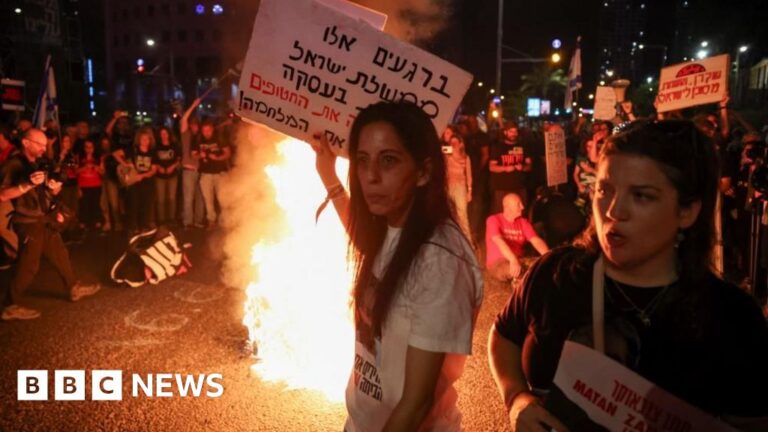- author, Lucy Williamson
- role, BBC Middle East Correspondent
- Reported by Jerusalem
-
For the leaders of both Hamas and Israel, ending the war in Gaza has become a life-or-death game for survival.
The terms on which the war ultimately ends could determine their political future and their grip on power – and, for Hamas leader Yahya Sinwar, even his physical survival.
That’s one reason why previous negotiations have failed – and why the question of how to end the fighting permanently has been postponed until the final stages of a plan presented by U.S. President Joe Biden on Friday.
Biden acknowledged that moving from limited hostage and prisoner exchange negotiations to permanent ceasefire talks would be “difficult.”
But the success or failure of this latest deal may hinge on this point.
The United States announced that it had submitted a draft resolution to the UN Security Council supporting President Biden’s three-phase ceasefire plan, which includes an end to the fighting, the release of hostages and the restoration of Palestinian territory.
Israeli Prime Minister Benjamin Netanyahu has strong domestic reasons for wanting to phase in the deal.
The first phase outlined by Biden would see the release of dozens of hostages, dead or alive, which will be widely welcomed in a country where the failure to free all hostages held by Hamas is for many a glaring moral stain on Netanyahu’s management of the war.
But Hamas is unlikely to hand over the most politically sensitive hostages — women, the wounded, the elderly — without some guarantee that Israel will not easily restart the war upon their return.
According to leaks cited by Israeli media on Monday morning, Prime Minister Benjamin Netanyahu told lawmakers that Israel could keep its options open.
Some believe that the option of resuming fighting until Hamas is “eliminated” is the bare minimum demanded by Netanyahu’s far-right coalition partners.
Without their support, he faces the possibility of early elections and continued corruption trials.
Netanyahu will need to keep his long-term options open to ensure he can secure their support in any initial hostage deal, while Hamas leaders are likely to seek guarantees of a permanent ceasefire up front.
Previous agreements have fallen into this gap. Whether it can be filled now will depend on how much room Netanyahu has to work with his far-right government allies to find alternatives to “excluding” Hamas, and how much Hamas leaders are willing to consider it.
Netanyahu spoke over the weekend about destroying Hamas’ “military and governing capabilities” and ensuring that the group no longer poses a threat to Israel.
There is no disagreement that Hamas has suffered heavy losses in its military infrastructure, and some have noted that it has even suffered heavy losses in popular support and control of the streets within the Gaza Strip.
But there is no indication that Israel has killed or captured the country’s top leaders, Yahya Sinwar and Mohammed Deif, and leaving them free in Gaza to celebrate the Israeli withdrawal would mean a political disaster for Israel’s embattled prime minister.
A State Department spokesman said on Monday that while Hamas’ capabilities have been “steadily degraded” in recent months, it remains a threat and the United States does not believe it can eliminate the group militarily.
Meanwhile, the White House said Biden “affirmed his readiness to move forward on the terms Israel has offered Hamas,” saying the Palestinian group remained the only obstacle to an agreement.
Meanwhile, Israeli military spokesman Maj. Gen. Daniel Hagari said the army would be able to ensure Israel’s security if the government agreed to a ceasefire.
But Yanir Kozin, a diplomatic correspondent for Israeli military radio station GLZ, believes Netanyahu will not end the war until he can view it as a success.
“The deal to take Hamas out is a big failure,” he said. “Eight months in, with none of the war’s objectives achieved – destroying Hamas, returning all the hostages, securing the border – he doesn’t want to end the war. But he also understands that he cannot postpone it until the next Israeli elections in 2026.”
“If he can say, ‘We have expelled Yahya Sinwar and Mohammed Deif. They do not live in Gaza,’ and if people living in Gaza and along the northern border can return, then I think he can maintain his government. But there are a lot of ifs.”
It is highly unlikely that Hamas would agree to expel its leaders or surrender, but clear divisions have emerged among Hamas leaders inside and outside Gaza.
Ehud Barak, a former Israeli prime minister and defense minister, said on Israeli radio on Monday that President Biden announced the deal “in the knowledge that Prime Minister Netanyahu would only move forward if he was convinced that Sinwar would veto it.”
“How do you think Sinwar would have reacted if he had been close to agreeing and then been told: ‘Hurry up because we’re going to have to kill you even after we return all the hostages’?” he said.
Meanwhile, tens of thousands of Israelis who were forced to flee after the Oct. 7 Hamas attack are watching the prime minister’s next move.
Among them is Yarin Sultan, a 31-year-old mother of three who fled her home in Sderot, on the Gaza border, the morning after the Hamas attack and said she would not return until Yahya Sinwar and Mohammed Deif were released.
“This ceasefire will kill us,” she told the BBC. “We will release the hostages, but in a few years you will be the next hostages, the next people to be killed, the next women to be raped. It will happen again.”
Additional reporting by Rushdie Abu Arulouf

